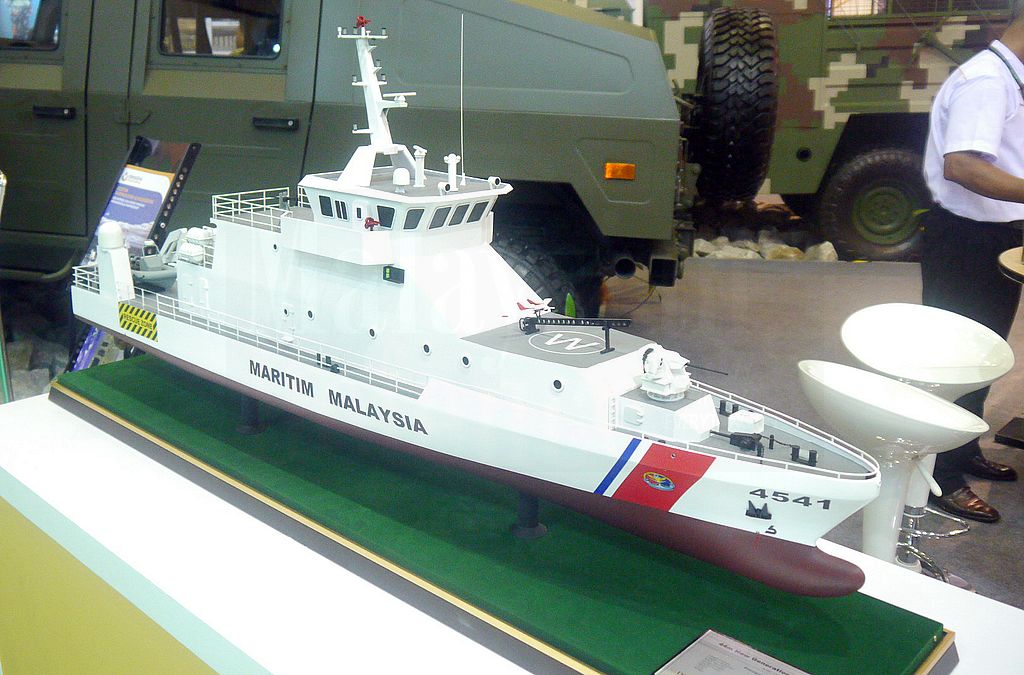
SHAH ALAM: The first of six New Generation Patrol Craft (NGPC) for the Malaysian Maritime Enforcement Agency (APMM) is expected to be launch next month. The keel for the first ship, built by Destini Bhd was laid on Nov. 20, last year at its facility at Port Klang.
Although the launch is on schedule, it must be noted that it will take at least another 12 months before the ship is commissioned into APMM. Perhaps APMM will be luckier in this regard compared to the senior service, RMN.
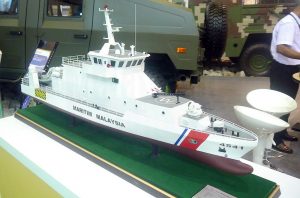
Anyhow, as Malaysian Defence had written various posts on the NGPC, please feel free to read them here HERE and Here.
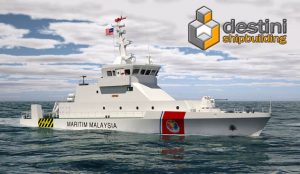
To recap, the NGPC is a variant of the Fassmer 40M Coastal Patrol Vessel. It is to be armed with a SMASH RWS fitted with a 30mm gun from Aselsan and two 12.7mm machine guns. It will also come equipped with the Fulmar X mini-UAV from Thales for ISR duties. Six of the vessel is being built at the shipyard formerly owned by Destination Marine Services Sdn Bhd. Destination Marine was bought over by Destini in 2015 after it got the contract for the NGPC.
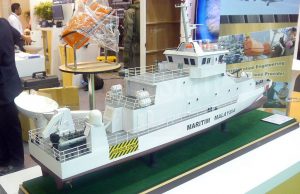
Destini will also be involved in the construction of the three 80-metre OPV program for APMM. It appears that TH Heavy was cognisant of the claims that it had no prior shipbuilding experience and therefore had entered a JV with Destini – the builder of the NGPC for the OPV program.
Last July when confirming it was in talks with APMM for the OPV program, it stated that the status of talks was in a flux.
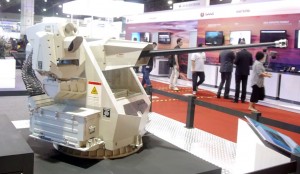
TH Heavy and Destini signed an agreement for a JV for the OPV project on 27th October, 2016, according to its announcement to Bursa KL on the same date.
The Board of Directors of TH Heavy Engineering Berhad (“THHE” or “the Company”) wishes to announce that the Company has on 27 October 2016 entered into a Joint Venture Agreement (“JVA”) with Destini Berhad (“DESTINI”) to establish an unincorporated joint venture to procure the award of contract in relation to the works related to the supply, delivery, testing and commissioning of three (3) units of approximately 80 metres Offshore Patrol Vessels (“OPV”) complete with fittings and accessories for the Malaysian Maritime Enforcement Agency (“MMEA”) (“Project”), including the performance of an Industrial Collaboration Program (“ICP”) as required by the Government of Malaysia and thereafter to undertake the execution and completion of the works in relation to the Project (“Works”) on a negotiated proposal basis (“Joint Venture”).
The JVA follows a Letter of Intent (“LOI”) dated 27 July 2016, received by THHE, for the supply, delivery, testing and commissioning of the OPV for MMEA.
2. INFORMATION ON DESTINI
Destini is a public company incorporated in Malaysia and listed on Main Market of Bursa Malaysia Securities Berhad. Destini Berhad is an integrated engineering solutions provider with diverse interests in the aviation, marine, land transport as well as oil and gas industries. As at to-date, the authorised share capital of DESTINI is RM 150 million divided into 1,500,000,000 ordinary shares of RM0.10 each while the issued and paid-up capital is RM115,523,029.90 comprising 1,155,230,299 ordinary shares of RM0.10 each.
3. SALIENT TERMS OF THE JVA
Under the Joint Venture Agreement, the Parties agree as follows:
(a) The Parties shall seek written approval of the Ministry of Finance (MOF) and/or any other relevant agencies for the award of the contract in relation to the Project (“Contract”) by MMEA to a consortium, which is to be formed between THHE Fabricators Sdn Bhd (“THF”), a wholly-owned subsidiary company of THHE and Destini Shipbuilding and Engineering Sdn Bhd (“DSBE”), a wholly owned subsidiary company of Destini.
(b) In the event that the Contract is awarded to THF and DSBE, the Parties shall require THF and DSBE to enter into a joint venture agreement. In such event, THF and DSBE shall perform the Works under the Contract.
4. RATIONALE AND PROSPECT FOR THE JOINT VENTURE
The rationale of the joint venture agreement is to capitalise on the complimentary expertise and resources of both parties to execute the Project and bid for similar projects in the future.
With the joint venture agreement, THHE and DESTINI will not only help enhance the nation’s goal for a more secured coastline, but will also diversify and strengthen both THHE’s and DESTINI’s shipbuilding portfolio.
Apart from a stronger shipbuilding portfolio, THHE and DESTINI will be able to potentially recognise stronger earnings to its shipbuilding business in the near term.
It is likely that TH Heavy was issued the LOI for the OPV program under a restricted tender process.
The contract for the OPV program is expected to be awarded to the JV between TH Heavy/Destini soon, industry sources told Malaysian Defence. It is likely that the contract will be awarded next month though the “public” contract signing will be conducted at LIMA 2017.
As this post is about the NGPC, I will write another entry on the OPV soon.
— Malaysian Defence
If you like this post, buy me an espresso. Paypal Payment

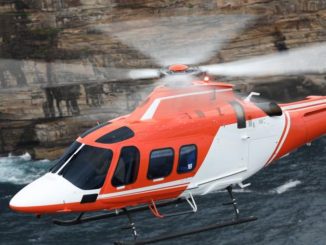
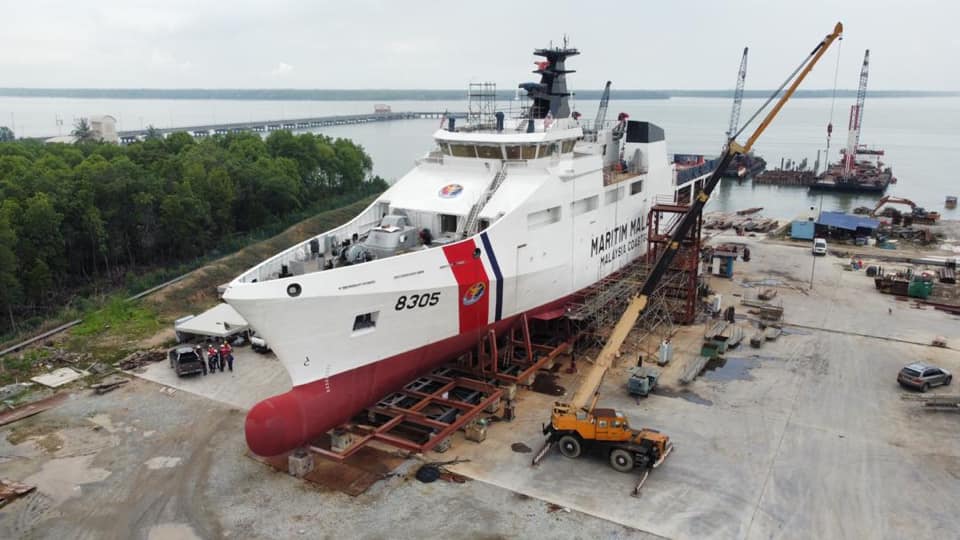
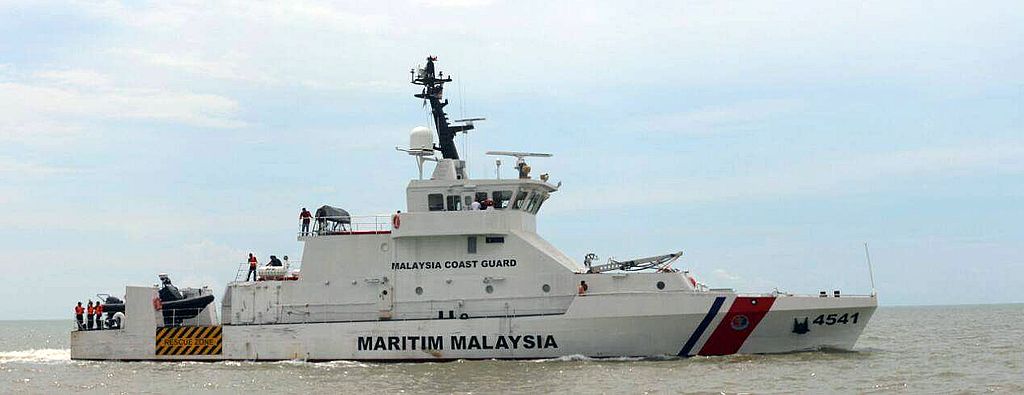
Actually with APMM getting the ex JCG patrol ships, I woud prefer the money allocated for the OPV to be used to buy more NGPC. The ex JCG OPV is big (90m) and has a displacement of more than 2000tonnes (the 1000tonne is its gross tonnage). APMM will be getting 2, nicely asking for 1 more would fulfill the OPV requirements nicely.
Right now the NGPC numbers need to replace the ex- vospers (15 ships) and later the ex- PZ (15 ships). the current 6 NGPC should just be the start, and probably another type with cheaper cost (no UAV for example) could be bought to replace the remaining old PC’s.
It is interesting to speculate on how keen the MMEA is on receiving the former Japanese ships or was the decision largely political? Yes, the MMEA is overstretched and any additional hulls are welcomed but the fact remains that both are 3 1/2 decades old and that keeping them running [despite being in immaculate condition] will take a lot of effort; to be expected with ships of this age. When transfers such as this occurs the new owner normally takes it as it is : it’s up to the new owner to decide if he wants to replace anything that will need replacing in the near future.
A dilemma often faced is to justify spending more than absolutely needed on old hulls that if anything, are seen as an interim or stop gap solution until something newer is available. The question regarding the former Japanese ships is how much equipment aboard will need replacing in the near future and the long term condition of critical items like the engine, gearbox, shaft and generators.
Reply
I was told that MMEA was offered new patrol vessels from Japan at friendly prices several years ago but it was declined. I believed this are the same vessels offered to the Philippines.
I believed the two ex JCG boats will not be used more than five years.
If these ships are working hard at sea, my concern is how often we get a chance to maintain the UAV and how often it is available for operation.
MMEA does not have personnel with prior experience operating UAVs.
Reply
That’s something they have
to learn through the hard way, hopefully it won’t be too hard. What services has experience with UAVs? The Armed Forces ones, Scaneagle, Aludra and Camcopter are operated and maintained by the lessor.
Some of the facts:
1) the ex vospers are now nearing 50 years old
2) the ex PZ is now around 35 years old
3) the ex JCG is around 25 years old
Do you use the limited budget now to still buy 3 ships that now can be performed by 2 ex JCG, and end up having more OPV (5 rather than 3) than is requested?
Or do you use the budget to replace the capability of your oldest ships (the ex vospers) and worry about the OPV capability when the ex JCG ships need to be replaced in the future? I believe 12 NGPC sould give a similar capability to the 15 old ex vospers ( how many has been retired and sunk as reefs? Recently was the ex KD Kris sunk as a reef in Terengganu)
Reply
Ex KD Rencong was sunk as reef near KK last week
Fulmar, if fishermen can use it properly, IMHO APMM can, assuming Fulmar X for law enforcement is as easy for the fishermen.
……….,
At the end of the day, trade offs always have to be made. As I mentioned, at most the former Jap ships are an interim/stop gap solution. A bit hard to make long term, firm plans when no commitment comes from above as to funding.
AM,
MMEA ships aren’t expected to be at sea for more than 2 weeks at a stretch. Plenty of time for preventive maintenance to be performed on the Fulmars. The question really is : how marinised are the Fulmars? Also, as part of the contract MMEA operators will be given training [actually its ongoing as I write this]. The MMEA having no prior UAS experience is the least of its problems.
Marhalim,
If I’m not mistaken the only UAS actually organic to the MAF are a handful of Schiebels operated by the Royal Intelligence Corps.
Reply
The Scheibel Camcopter system has two air vehicles. BSPP may the unit operating it but it’s operations and maintenance are done by the company that was featured by my posting during Lima
The key difference with the ex Jap ships and the PVs and PZs is that the Jap ships are larger. As a rule of thumb the larger a platform is, more maintenance is required. Which in turn equates to more expensive to run and maintain. As such, running the 50 year old PVs could still be cheaper than running the younger ex Jap ships.
Also, the Jap ships, being built for ops in Japanese waters [deeper waters with rougher Sea States], will have better sea keeping than the PVs and PZs which were designed from Day One for littoral ops. If anything, the high freeboard of the ex Jap ships is a indication of the environment they were designed to operate in and the operational requirements of their previous owners. On the NGPCs, it looks a bit awkward having the UAS operated from the ‘B’ position and to me at least, the high bridge makes it look a bit top heavy but I could be wrong.
As for the fate of the ex vospers.
If not mistaken one of the first was sunk off tioman a few years ago. This year APMM has transferred 5 more ex vospers to jabatan laut for them to sink as artificial reefs. The ex renchong and ex kris is part of the five ships. So now we know at least 6 ex vospers has been retired from APMM.
@ azlan
The ex jcg ships (erimo class) is really an “offshore” OPV (90m length, 2000tonne displacement), which should be compared only to the APMM future 80m new OPV and probably the ex musytari’s. It is one of the earliest large patrol ships specially built for jcg (the PL-01 is a single ship only) and previously jcg large patrol ships was ex Japan navy frigates / destroyers. In all 7 ships was built in the class (PL-02 to PL-08, nearly all has their name changed at some point of their lives so it is easier to call them by their pennant numbers instead). One of their complaints are the low 20 knots top speed (to intercept north Korean spy ships) so the next class of large OPV’s in jcg has higher top speed.
Reply
Based on what you described about the PL boats, maybe APMM should used them as mothership or sea bases
……….,
I’m aware that the ex Jap ships are deep water OPVs [it’s plain to see from their high freeboard and displacement] and are not comparable to the MMEA’s PVs and PZs but the reality is that the RMN and MMEA are so overextended that ships are used for roles they were not originally intended to perform, i.e. the use of Sotong [sold of], the Mahamirus and FACs for routine patrols. The main concern with the ex Japs ships is the cost of running them and how maintenance intensive they’ll be on account of age.
Yes, it would make sense for both the be used as tenders [a role the RMN uses the Indera Saktis and before that the Banggi, Jarom and Lankawi for] to support MMEA ships operating in the Sptratlys area. Ideally, there will come a time when the MMEA has enough assets to be able to have more of a sustainable presence in the Sptralys; this would relieve some pressure of the RMN and would be more appropriate given that the Chinese ships intruding in our waters are not PLAN but China Marine Surveillance ships performing what China calls ”weiquan zhifa” missions.
@ Azlan
Original MMEA aquistition plan for 2011-2015 (Fasa ke 2 perancangan strategik APMM) was for them to get:
– 2 more CL-415
– 6 more medium lift helicopters
– 2 large OPV
– 8 medium PV
– 2 training ships
– 25 fast interceptors
– 8 SAR lifeboat
– 50 RHIBs
SLEP
– 1 large OPV
– 13 medium PV
So in reality the APMM has planned for a large OPV, and the donation of 2 erimo class OPV will fulfill this prior requirement. This means that the 2 ex JCG ships will be used in the role that APMM is planning for in the Fasa ke 2 perancangan Strategik APMM 2011-2015.
As you say, the APMM is now overextended. I believe that this could be partly solved by diverting the budget for the 3 new large OPV to buy more NGPC’s (should be enough for 6-9 ships) to replace all of the ex vospers. I do believe that APMM needs more medium sized ships rather than ending up with 7 large OPV’s (2x Musytari, 2x JCG Erimo, 3x New Large OPV)
This is the current Medium Sized Patrol Boats in APMM service:
15x Sipadan Class (ex vospers, 6 or more of this has been retired)
15x Gagah Class (ex PZ)
5x Ramunia Class (ex Bahtera)
@ azlan
We do have a ready “tender” in the spratlys. I think it is time for APMM to station its patrol boats in pulau layang-layang. We should also encourage malaysian fishing boats to use pulau layang-layang as a stopover or a refuge from heavy sea conditions. More berthing facilities, fuel transfer areas should be built in pulau layang-layang to support malaysian fishing boats and also APMM patrol boats.
………… – ”This means that the 2 ex JCG ships will be used in the role that APMM is planning for in the Fasa ke 2 perancangan Strategik APMM 2011-2015.”
They will be used for whatever roles they are needed for. Like the armed services the MMEA’s plans and operational realities can be slightly different. Given the shortage of assets; the MMEA often has no choice but to utilise whatever it has; even for roles a particular class of ship isn’t or is ill suited to perform [same goes for the RMN]. As such, it will be expected that the ex Jap ships might – from time to time – be called upon to perform a role that would idelly be performed by a smaller ship.
………. – ”I believe that this could be partly solved by diverting the budget for the 3 new large OPV to buy more NGPC’s (should be enough for 6-9 ships) to replace all of the ex vospers.”
Personally, I don’t see why the MMEA needs OPVs at the moment, given its operational commitments which don’t call for extended patrols [exceeding 2 weeks] anyway where a ship is no more than a couple of days away from the nearest base/port. I know an ex RMN guy who is now in the MMEA and his personal opinion is that OPVs the size of Marikh and Mystari are not needed.
Good to know APMM have a wishlist, but it omittted how many new shore facilities it need like coast guard stations, airstations & coastal radars. Govt have to invest in these too, a strain for APMM when have more vsl/planes/men but have to compete for quarters with other federal staff, compete for berthing space with other maritime agencies.
Reply
The radars watching the coast lines and islands are all owned by MMEA apart from the ones in ESSCOM. As for facilities this goes back to the decision not to absorb Marine Police or vice versa
“Personally, I don’t see why the MMEA needs OPVs at the moment, given its operational commitments which don’t call for extended patrols [exceeding 2 weeks] anyway”
Earlier you said “Ideally, there will come a time when the MMEA has enough assets to be able to have more of a sustainable presence in the Spratlys” so I am confused.
………,
As mentioned previously, the jetty at Layang-Layang can only accommodate FAC size ships. Another issue is the depth of the water leading to the jetty and lenght of the jetty. We are unlikely to take steps such as dredging the immediate area to make it deeper or to enlarge the jetty due to political reasons.
With regards to encouraging Malaysian fishermen to operate in the area; our policy is that the area is a restricted security area closed to outsiders. In the past some Vietnamese trawlers use to venture in the area but not anymore; now it’s a 100 percent Chinese affair.
Unlike the case with the Philippines in which disputed areas are traditional fishing grounds for Filipino fishermen; the parts of the Spratlys claimed by us were never or hardly ventured into by Malaysian fishermen; this has been the case for decades.
AM,
No reason to be confused.
At the moment due to a shortage of hulls the MMEA has a minimal presence there; the main effort is by the RMN. The MMEA needs additional hulls to be able to deploy assets on a more sustainable basis to several areas including the Spratlys but those assets don’t necessarily need to be OPVs. A ”sustainable” presence can be achieve by having smaller ships; the key is to have enough ships. OPVs come in useful when the MMEA is faced with a situation where it has to deploy further way from the coast for longer periods and when the sea gets rough. Will be useful to have some OPVs but the focus should be on replacing the PCs and PZs and a problem is that OPVs will cost more to not only buy but also operate.
If an OPV is able to cover more territory and spend more time, on one journey out to the Spratlys, doesn’t it make the MMEA’s presence more sustainable than a PC?
Or do you mean that just having more PCs and being able to go out but not stay long is good enough.
@ am
It is a bit more complicated than that.
Take into account:
1) mmea plan was for additional 2 OPV to add to the 2 ex musytari’s. When the budget is announced it seems that they can squeeze an additional ship, then it became 3. Then came the Japanese offer for 2 free opv’s.
2) there is still some remaining 50 year old vosper pc’s on duty. The opv budget if diverted is enough to buy additional NGPC’s to finally replace all of the vospers 1 to 1.
AM,
MMEA ships are based from Labuan; they don’t have very far to go to reach the Spratlys. On top of that, all the reefs/islands we claim and have a presence on are fairly reachable, they’re not too far from on another. Given that ships normally spend about 2 weeks at sea; even a NGPC has the needed range and endurance for a regular or sustainable deployment there. All ships also carry emergency fuel, water and food in case their deployment is prolonged.
The main value in having a OPV is when Sea States get rough; rough enough for a NGPC or a similar size vessel [like the Vosper PCs and the RMN’s FACs] to have problems. Another bonus of course is that a OPV has more range and endurance [if needed] and has the internal and deck space to carry people [in the event a rescue at sea is mounted]. The main issue is that OPVs, being larger, will be more expensive to operate and run – ideally the MMEA’s operating budget will be increased to take into account the OPVs. If indeed a OPV size ship was needed by the MMEA in the Spratlys; the former Marikh and Mystari would be based not in Langkawi but in Labuan.
Actually ex kd marikh and ex kd musytari at kk and kuantan…
Its December, launch before Christmas Day?
Reply
Next week, if everything goes as planned.